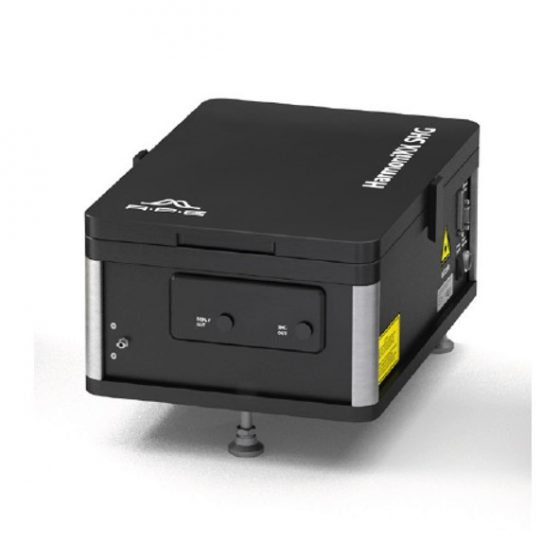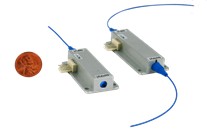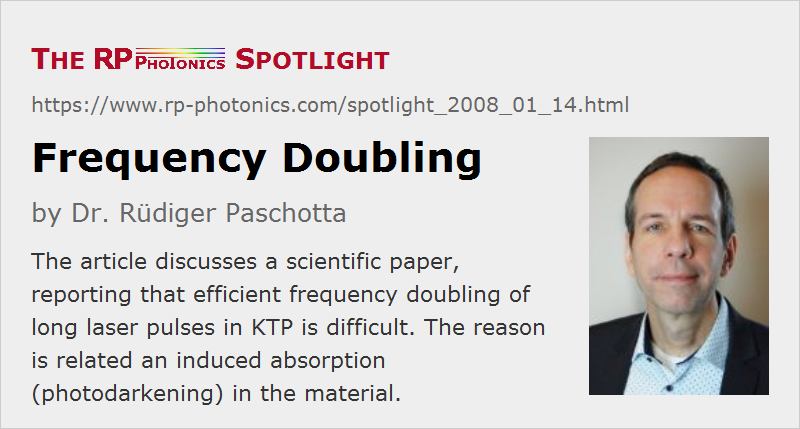Frequency Doubling
Posted on 2008-01-14 as part of the Photonics Spotlight (available as e-mail newsletter!)
Permanent link: https://www.rp-photonics.com/spotlight_2008_01_14.html
Author: Dr. Rüdiger Paschotta, RP Photonics AG, RP Photonics AG
Abstract: The article discusses a scientific paper, reporting that efficient frequency doubling of long laser pulses in KTP is difficult. The reason is related an induced absorption (photodarkening) in the material.

Ref.: S. Favre et al., "High-power long-pulse second harmonic generation and optical damage with free-running Nd:YAG laser", IEEE J. Quantum Electron. 39 (6), 733 (2003); encyclopedia articles on frequency doubling and photodarkening
Frequency doubling can be efficiently performed either by intracavity frequency doubling in a continuous-wave laser, or with a Q-switched laser (intracavity or extracavity). It thus seems surprising what the paper cited above reports: frequency doubling with long pulses is difficult – at least at high power levels.
The authors worked with a powerful Nd:YAG slab laser, producing pulses with 0.1-5 μs duration and a peak power of 1-2 kW. The high average power forced them to use extracavity doubling, as the thermal effects in the nonlinear crystal (made of KTP) would have been to strong to tolerate them within the laser resonator. With proper focusing, the optical intensity could easily have been made high enough for efficient doubling, but the trouble was that crystal damage set in well before a high efficiency was achieved. The problem is apparently the following:
- When a high second-harmonic intensity is present for a longer time (hundreds of microseconds), the KTP crystal becomes absorbing. Apparently, temporary color centers are the origin of this photodarkening. The color center formation may be related to two-photon absorption.
- Absorption of the high infrared intensity subsequently leads to damage. (The second-harmonic light is also absorbed, but has a lower intensity.)
This explains why frequency doubling with nanosecond pulses works better. In continuous-wave operation, the situation should be even worse, as the color centers would have even much more time to build up. A solution can be intracavity doubling, where far lower optical intensities are required for efficient conversion: the non-converted infrared light is “recycled” in the laser resonator. However, intracavity doubling is limited in average power, as mentioned above.
Of course, one may use a crystal material which does not have these temporary color centers. The authors reported slightly better results with LBO, but unfortunately without elaborating on damage and induced absorption. LBO is probably better in this respect, although it does need to be operated with higher intensities due to its lower nonlinearity. Even if damage is no issue, it is sometimes difficult to reach sufficiently high intensities with long pulses or in continuous-wave operation.
So we see that frequency doubling long pulses (and in continuous-wave operation) can be problematic. The Photonics Spotlight 2007-03-05 explained why very short pulses are also involving difficulties – for entirely different reasons.
Suppliers
The RP Photonics Buyer's Guide contains 38 suppliers for frequency doubling devices. Among them:


APE
Nonlinear frequency conversion in SHG crystals makes it possible to generate new shorter wavelengths from existing laser wavelengths. As part of our HarmoniXX product line, the HarmoniXX SHG is a frequency converter for the frequency doubling of ultrashort-pulse lasers.
The focus is on user-friendliness and a compact design. By featuring a quick exchange of optics, the HarmoniXX Second Harmonic Generation device can be used for a wide pulse duration range, from femtoseconds (fs) to several picoseconds (ps).
See our specifications for more details.


HC Photonics
HC Photonics (HCP) offers both commercial off-the-shelf (COTS) and custom PPMgO:LN or PPMgO:LT based frequency doubling devices for wavelength ranging from 710 nm to 5000 nm.
The product mix includes bare crystals (bulk and waveguide) and plug-and-play fibered mixers. Key features:
- >200 kinds of commercial off-the-shelf (COTS) crystals with oven/holder for shipping today
- wavelength range: 710–5000 nm (355–2500 nm output after doubling)
- fibered mixer is single-pass, high-efficiency and optimized for specified input pumps
- available for fiber or free space as input/output coupling interfaces (such as 1×0, 1×1 or 0×0; 0 = free space, 1 = one fiber)
- >2W CW 780 nm 1×1 fibered waveguide mixer is an excellent device for quantum application
- >4 W visible 1x0 fibered bulk mixer is a robust, compact and easy-to-use device for biophotonics, metrology and quantum applications


NKT Photonics
Do you need to address the wavelengths of rubidium, strontium, barium, or ytterbium? With our new Koheras HARMONIK high-power frequency-converted laser systems, you can! The Koheras HARMONIK is a range of single-frequency mode-hop free and ultra-stable narrow-linewidth fiber lasers. They deliver high power and narrow linewidth light at the exact atomic transition you need for your quantum application. If you are looking for high-quality light for quantum computing, sensing, metrology, and communications, try this new class of lasers. They have an inherently robust single-frequency design with low phase and intensity noise, high OSNR, and high optical power. All with industrial reliability.


EKSMA OPTICS
Our nonlinear crystals for second harmonic generation include a wide choice of BBO, LBO, DKDP, KDP and KTP crystals for quick delivery. We also offer AgGaS2, AgGaSe2, GaSe, ZnGeP2, LiIO3 and KTA crystals for SHG at IR and mid-IR wavelengths. We also offer technical consulting services helping to choose and specify optimal crystal material, orientation and coating design for your particular application.


GWU-Lasertechnik
GWU's frequency conversion devices are flexible solutions for pulsed lasers. By means of second harmonic generation (SHG), third harmonic generation (THG) and fourth harmonic generation (FHG), not only the wavelength range but also the versatility of laser sources can be vastly extended. The UHG series offers widely tunable harmonic generation in a compact, modular design for ultrafast laser oscillators. Broadband optics for complete wavelength coverage ensure convenient usability and best performance.


TOPTICA Photonics
TOPTICA provides frequency-doubled continuous-wave diode and fiber lasers. The wavelength range covers 330 nm – 780 nm with up to 20 nm of tuning. In addition, stand-alone resonant frequency-doubling units are available.


Radiantis
Radiantis offers second harmonic generators for MHz repetition-rate femtosecond and picosecond Ti:sapphire oscillators with conversion of efficiencies of 50%. The company also provides femtosecond SHG devices to double the 990 – 1550 nm range into the 495 – 775 nm range. Products are fully automated. Customised frequency doublers for other spectral ranges can also be developed.


Shalom EO
Shalom EO offers a vast variety of nonlinear crystals for frequency doubling including BBO, KDP and KD*P, PPLN waveguides, LBO, KTP, HGTR KTP, BIBO, LiNbO3 and MgO:LiNbO3 crystals, in addition to the infrared nonlinear crystals ZnGeP2 (ZGP), LiIO3 and KTA.
Both off-the-shelf and customized products are available.


Covesion
Frequency doubling/SHG crystals: Covesion has SHG crystals and waveguides held in stock that can be dispatched promptly to meet your application requirements. Our team of industry-leading experts are on hand to assist in the fulfilment of more specific user requirements using our custom manufacturing capability.
Stock MgO:PPLN SHG crystals and waveguides are available for a wide range of common pump laser wavelengths from 976 nm to 3300 nm, allowing generation of light between 488 nm and 1650 nm.
All stock crystals come ready clip-mounted for seamless and straightforward integration into our crystal ovens.
The addition of MgO:PPLN waveguides to the Covesion product range allows end users to exploit greater conversion efficiencies and save on unnecessary pump sources within their applications. Waveguides are available as standalone chips or as robust, ruggedized packages with APC fiber connectors.
This article is a posting of the Photonics Spotlight, authored by Dr. Rüdiger Paschotta. You may link to this page and cite it, because its location is permanent. See also the RP Photonics Encyclopedia.
Note that you can also receive the articles in the form of a newsletter or with an RSS feed.
Questions and Comments from Users
Here you can submit questions and comments. As far as they get accepted by the author, they will appear above this paragraph together with the author’s answer. The author will decide on acceptance based on certain criteria. Essentially, the issue must be of sufficiently broad interest.
Please do not enter personal data here; we would otherwise delete it soon. (See also our privacy declaration.) If you wish to receive personal feedback or consultancy from the author, please contact him, e.g. via e-mail.
By submitting the information, you give your consent to the potential publication of your inputs on our website according to our rules. (If you later retract your consent, we will delete those inputs.) As your inputs are first reviewed by the author, they may be published with some delay.


Connect and share this with your network:
Follow our specific LinkedIn pages for more insights and updates: